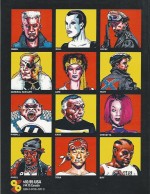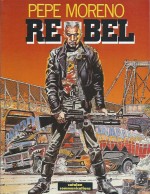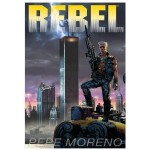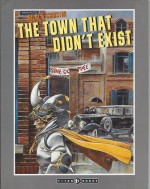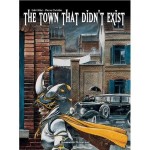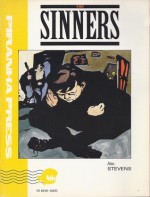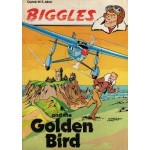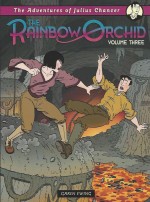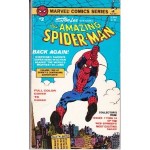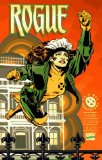
By Liberatore & various (Catalan Communications)
ISBN: 978-0-87416-015-4
(1985) ISBN-10: 0874160154 Dimensions: 8.5 x 0.2 x 11 inches
Italian arts superstar Gaetano “Tanino†Liberatore was born in 1953 in Quadri in the province of Chieti. He went to school in Pescara and studied architecture at the University of Rome before moving into the world of work as an advertising illustrator in 1975.
He first met iconoclastic writer, artist and publisher Stefano Tamburini in 1978 and with strident activist cartoonist Andrea Pazienza, they created ‘Rankxerox’ for the magazine Cannibale. The character evolved and moved to Il Male and eventually Frigidaire, fully realised now as the RanXerox we know today.
Liberatore was rapidly developing as both artist and writer, with strips ‘Bordello’ and ‘Client’ appearing in Il Male, but when the new, Tamburini-scripted syndicated RanXerox became a star of French magazine L’Écho des Savanes in 1981, Tanino moved to Paris and began working simultaneously on short complete tales for the more prestigious Gallic market in such magazines as Tranfert, Métal Hurlant, À Suivre and Chic. A shocking hit in the US Heavy Metal magazine, RanXerox then led to Liberatore jumping the pond and producing material for Twisted Tales and men’s magazine Hustler.
Some of those aforementioned short fiction pieces comprise the contents of this bleakly disturbing, ultra-violent yet oddly philosophical exploration of the consuming effects of media and fashion.
When his great collaborator Tamburini died in 1986, Liberatore quit comics for nearly a decade. Returning to straight commercial illustration, he worked in movies and designed book and record covers. Eventually, comics captured his attention again, and he produced two new RanXerox tales in 1993 and 1996 (with Jean-Luc Fromental and Alain Chabat), and a piece in Batman Black and White, assorted covers, and illustrated Pierre Pelot and Yves Coppens’s mass-market paperback ‘Le Rêve de Lucy’. As the Nineties closed, he finally came storming back in stunning style with the brilliant, award-winning Lucy L’Espoir in 2007, in which he and writer Patrick Norbert freely adapted a life-story for the famous prehistoric humanoid Australopithecus Afarensis remains found by anthropologists Coppens, Donald Johanson and Maurice Taieb.
Still available but desperately in need of a modern re-release, Video Clips gathers seven short, sweet and sour, vitriolic, challenging thrillers by the stylishly abrasive young Liberatore beginning with the self-authored ‘Real Vision’ in which a young celebrity-fuelled punk commits atrocious acts of violence on a mother and child simply to commit “suicide by television†after which the Tamburini-penned ‘Earth versus Saturn’ turns a wickedly sardonic eye on movie mania as a scout party for invading aliens picks the wrong bar to begin their fact finding mission. Of course, it would have helped if they hadn’t used thirties movies stars as templates for their temporary Earth-bodies…
He also scripted ‘E.M.P.S.: Erotic Management for People’s Socialism’ – an outrageous spoof of psychology, political correctness and sexual repression in a hilarious and shocking science fiction setting, whilst the deeply disturbing ‘Shut-In’ by Bruce Jones might be familiar to older American readers as it first appeared in Twisted Tales #7, detailing the saucy, savage hidden hi-jinks of a babysitter and her abusive jock boyfriend as they mischievously tend to a stroke-paralysed senior citizen one night – and of course there’s a superb sting in this tale…
‘Bololy Folly’ is another Tamburini psycho-thriller as the latest technology to tame “wild chromosomes†and bad behaviour cataclysmically comes a-cropper on live television whilst ‘Watch Out for Hot Flashes’ – scripted by the enigmatic G. Setbon – offers a more traditional tale as the world’s greatest fashion model offers an exclusive chance to the photographers who made her famous. Sadly she’s the one doing the shooting but her murderous motives simply defy all logic…
This powerfully compelling collection ends with another Tamburini tale as ‘Tiamotti’ describes the trials of three bomb-making anarchists as they try to defeat a security system which can read their minds and deliver a fusillade of withering gunfire in the blink of an eye…
Crafted in a range of palettes from tension-wracked monochrome line-art to tantalising tonal washes, and even including three lush full-colour paint jobs, this sexy, severe and staggeringly violent tome is a superb introduction to the graphic genius and brutal worlds of Liberatore: places no adult fan of sequential narrative can see without being changed forever…
Art © 1985 Gaetano Liberatore. All stories © 1985 their respective authors. English language edition © 1985 Catalan Communications, All rights reserved.

